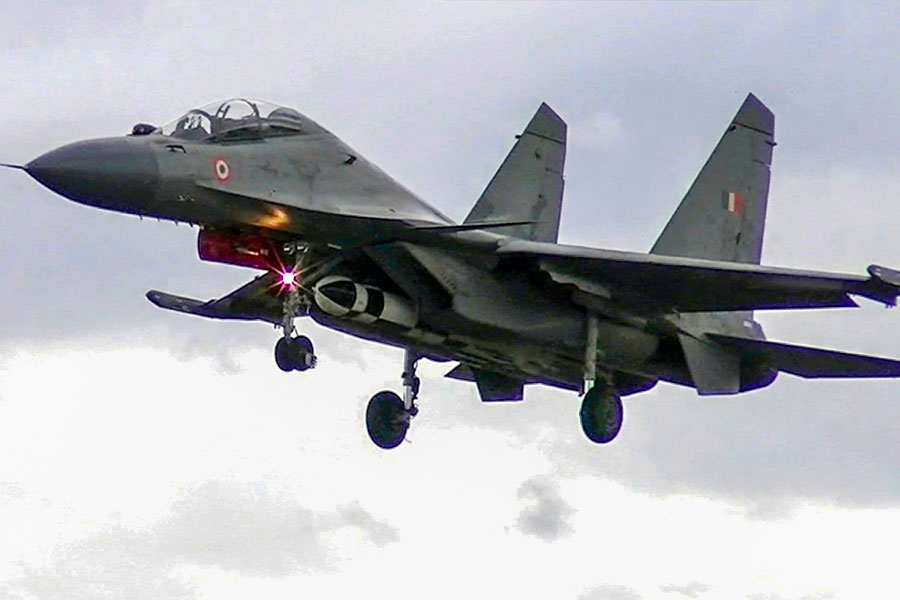Transforming India into a major defence export power
India can realize the target of achieving defence exports of US$ 5 billion in next five years and US$ 10-15 billion in next decade if it is able to provide policy stability, correct identification of potential items, complete product solution and active institutional support for marketing of defence equipment.

Image Credit : PIB
According to a report released by Stockholm International Peace Research Institute (SIPRI) in March, 2021 India’s arms imports fell by 33% in 2016-20 when compared to the 2011-15 period. However, India is still the second largest importer with Russia (49%), France (18%) and Israel (13%) being the top three suppliers.
The drop in India’s imports happened primarily due to reduction in total imports from Russia and US by 53% and 46% respectively from the previous period. This figure is bound to increase in the next five years as there are outstanding deliveries of several combat aircrafts, ships, submarines and air-defence systems.
There has also been an improvement in India’s export of arms in 2016-20, which have increased by 228%. India now holds 24th rank amongst arms exporting nations with its share increasing to 0.2% from 0.1% in the given period. Its major exporting partners are Myanmar (52%), Sri Lanka (24%) and Mauritius (13%). Given the capabilities of India’s defence industry and opportunities that exist in the world market, this figure is not very encouraging and several steps are required to be taken to make India a major defence export power.
History of defence infrastructure
After its independence in 1947, India inherited 16 ordnance factories, an aircraft plant and two shipyards from British rule. During 1950s, India had little technical knowhow to produce sophisticated defence equipment, so its requirements were fulfilled mostly through imports.
In the initial years after independence, defence sector received less priority as governments’ threat perception after war with Pakistan in 1948 in Kashmir was low. But after the humiliating defeat in the war against China in 1962, India’s defence expenditure increased from 2.0% in 1960 to around 4.0% in 1963.
It was during this time that India’s defence ties with erstwhile Soviet Union were strengthened. Soviets offered India technology through licenced production and favourable terms of payment for buying defence equipment. However, during this era, which lasted till mid-1980s, there was very little technological advancement as licenced production arrangements with Soviet Union consisted only for assembly and basic sub-component manufacturing.
Moving from licence-based production to co-production
In 1988, India entered into a joint venture with Russia to develop a ‘Brahmos’, a supersonic cruise missile system. Besides this, India has also signed several agreements with Russia in the area of space collaborations and developing sophisticated weapons.
During this period India also established good relationship with other prominent defence equipment producing nations like Israel and US. In particular, there was a significant improvement in India-US defence ties. In 2005 both countries signed a ten-year defence co-operation framework to strengthen the strategic relationship through higher collaboration in co-production and R&D.
De-regulation of defence sector
Till the 1990s, India did not follow export promotion of defence equipment aggressively. Traditionally, it has not supported export of arms that can fuel conflicts indirectly and has been primarily exporting low value and non-lethal defence items like light weapons, army uniforms, trucks, patrol boats etc.
In 2001 India deregulated defence sector for private players. In 2002 procedural guidelines called Defence Procurement Procedure (DPP), to streamline procurement of defence equipment for armed forces were introduced.
After 2014, a separate strategy for promotion of export of defence products was formulated and specific incentives were introduced under Foreign Trade Policy (FTP). Ministry of External Affairs (MEA) was asked to facilitate creation of lines of credit for foreign countries to import defence items from India and EXIM Bank has been asked to finance defence exports from India.
To encourage FDI in defence sector, Government of India under its “Make in India” initiative has now allowed up to 74% through automatic route (from the earlier 49%).
In August 2020, Department for Promotion of Industry and Internal Trade (DPIIT) has also suggested several measures to attract foreign investors and boost domestic defence manufacturing. This includes capital expenditure and R&D subsidy, tax exemptions, cheaper finance and one-stop shop for clearances.
DPIIT has suggested that there will be no changes to the Defence Procurement Policy for 4-5 years. This will help in boosting the confidence of the industry for making long-term investment decisions as against several changes made in policy earlier.
Steps required to enhance India’s defence exports
There are large number of countries in the world which maintain large army and police forces without any manufacturing base. This provides ample opportunities for India to supply arms, especially to developing and less developed nations.
Countries like Algeria, Morocco and Angola in Africa and Burkina Faso and Mali in Sub-Saharan Africa are major importer of arms and are currently importing majorly from Russia and US. Besides these markets, India can concentrate for export of arms in Middle-East Asia (Saudi Arabia, UAE and Qatar) and also consolidate its position in India Ocean Region (IOR).
India, in the initial phase can concentrate on exporting selective medium/high technology arms. There has been considerable interest in India’s Brahmos missile, Pinaka multi-barrel rocket launcher, Advanced Light Helicopter, naval craft/ships, air defence system and air-to-air missile. Tejas, the multirole light fighter aircraft, recently cleared by Cabinet Committee on Security (CCS) can be another prospective product for export.
Besides this there is scope for exports in non-lethal military equipment. India has been successful in exporting bullet-proof jackets to many countries of the world.
Similarly, India should identify other items, which are required by defence forces and are imported from other countries, as potential items of export.
India, rather than just exporting defence product, needs to provide complete defence solutions, which also includes providing technical knowhow, providing spare parts and training to operate the arms. This will help India in gaining acceptance, especially among less developed nations.
There have been many policy decisions taken by the Government recently to enhance domestic capabilities and attract FDI in defence manufacturing. It is important to translate this on ground. Foreign and private players will be encouraged to make investment only when there is policy consistency and less cumbersome procedures for obtaining licences.
Finally, institutional support from the Government side is required to help marketing of ‘Made in India’ products. A full-fledged Directorate supported by Indian embassies in different countries should work closely with the industry. They should not work just as facilitators, but work pro-actively to identify opportunities in different markets and promote sales of Indian defence equipment.
India can realize the target of achieving exports of US$ 5 billion in the next five years and US$ 10-15 billion in the next decade if it is able to provide policy stability, correct identification of potential items, complete product solution and active institutional support for marketing of defence equipment.

Dr. Anuj Sharma is working as Associate Professor and Chairperson, Centre for International Business & Policy, BIMTECH, Greater Noida. He has more than 20 years of teaching experience at post graduate level. His current areas of interest are globalization, international marketing, international trade operations, foreign trade policy and sector specific export strategies. He has presented papers and chaired sessions at various national and international conferences. He has also written case studies and research papers in various national and international journals of repute.
He has conducted more than 30 Management Development Programs (MDP) in the area of International Business across all parts of the country. This includes both open and in company programs for reputed government organization like State Trading Corporation (STC), PEC Limited, Handloom and Handicraft Export Corporation (HHEC) and private organizations like Godfrey Phillips India Limited. In association with Federation of Indian Exporters Organisations (FIEO), as Program Director, he has successfully completed seven batches of part time Diploma in Foreign Trade (DFT) for working executives. He has been instrumental in forging relationship with many corporate, trade associations, embassies and public sector enterprises. The views expressed here are his own. Usual disclaimers apply.













Nice to know all the information and feel proud of our nation !
Compliments for excellent write-up !